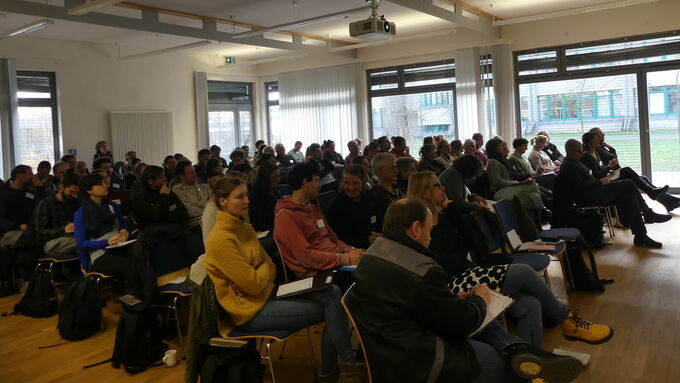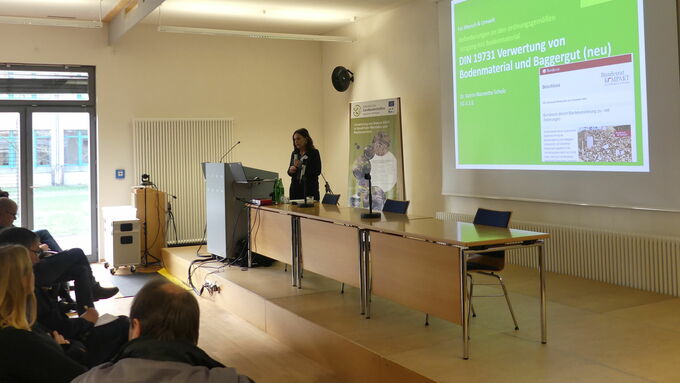About 80 participants listened to the presentations of the experts from different fields. © Bezirksregierung Münster
download picturemain content
Project of the month
#03/2023 EXPERT CONFERENCE WITH WORKSHOP
Soil borrow and reuse of soil material in nature conservation measures
On 9 February 2023, the LIFE IP Atlantic Region DE in cooperation with the ‘Natur- und Umweltschutzakademie NRW’ (North Rhine-Westphalian academy for nature and environment conservation, NUA) once again held an expert conference with workshop. The idea for this event arose because a variety of different nature conservation measures are implemented within the framework of the LIFE IP in which soil material is to be extracted and reused. In doing so, the project team and the local stakeholders on site sometimes face major challenges - from required permits for the intervention to the necessary soil analyses to the appropriate reuse of the material. The time required and the resulting costs often exceed the available budget, so that it happens again and again that measures important for nature conservation cannot be implemented or can only be implemented in part. The aim of the event was therefore to bring together many interested parties for an exchange of experience and knowledge and to provide assistance for practical implementation.
For better planning and assessment of existing knowledge and expectations, a link to an online survey via Lime-Survey had been sent to the local project participants of the LIFE IP together with the event notice in advance. Forty people filled out the questionnaire with twelve short questions completely and a large majority indicated that they also wanted to participate in the event. Almost half of the participants in the event probably gave feedback. Due to the field of activity surveyed, the answers probably reflect a representative picture, at least for the employees of biological stations or lower nature conservation authorities.
More than two thirds of the respondents indicated that they had no experience with commissioning soil analyses. Only four respondents stated that they were already well acquainted with this topic. A comparable result was found with regard to the question about previous experience in the area of permits regarding soil protection: half of the respondents stated that they had no experience with this, almost as many stated that they were unsure about how such a procedure should proceed, and only three persons stated that they were already well acquainted with it. When assessing the time required for soil-specific issues, around 42 percent answered that the implementation of measures would never or at least only occasionally fail because of this. However, as many as 15 percent stated that the time required would often lead to the failure of a measure. The cost factor for transporting the soil material was rated more critically: Half of all respondents stated that the costs occasionally prevented implementation; another 35 percent stated that this was even often the case.
With regard to the question which topics should be included in the workshop, the entire range of expectations was filled in as free text: from the presentation of the legal framework and current changes to general procedures and other technical input, practical aspects in particular were mentioned, such as criteria for reuse or disposal of the extracted soil material, information on cost calculation, general exchange of experience with the hope of further suggestions and contacts as well as presentation of best practice examples.
About 80 participants came to the NUA in Recklinghausen on the day of the event - mostly employees from the lower nature conservation authorities and the biological stations as well as from the lower soil protection authorities, from water management, from planning offices and from (nature conservation) associations. After the welcome by NUA Director Norbert Blumenroth, Dr Martina Raffel on behalf of the LIFE IP team and moderator Eva Pier, the presentation by Dr Ute Hamer from the Institute for Landscape Ecology at the Westphalian Wilhelms University Münster entitled ‘Protection worthiness of the resource soil’ was connected via internet. She explained general aspects of this valuable resource and emphasised in particular the soil's function as a water and carbon reservoir. In the assessment of soil quality and the preservation or rehabilitation of soil functions for biotope development, conflicts can occasionally arise between the various actors. As is so often the case, the key to successful interaction lies in clear communication of the objectives and differentiated explanation of the planned measures.
In the following presentation ‘Requirements for the proper handling of soil material: DIN 19731 Utilisation of soil material and dredged material’, Dr Katrin-Nannette Scholz from the Federal Environment Agency gave a detailed insight into the revision of the DIN standard first published in May 1998. Its complete technical and editorial revision was taken up in 2018 by a 13-member working group under her leadership. The requirements for the utilization or reuse of dredged material/soil material are described in the new standard as far as necessary and possible. The structure of the standard is intended to reflect the logical approach to the utilization or reuse of soil material. The final publication is targeted for spring 2023.
Heribert Tenspolde from the Münsterland District Office for Agricultural Structure of the North Rhine-Westphalia Chamber of Agriculture explained the perspective for potential agricultural utilisation of extracted soil material in his lecture ‘Soil utilisation from the perspective of agriculture - requirements, opportunities and limits’. Using numerous examples from his many years of experience, he went into detail about the aspects to be considered and the problems that always arise. Here, too, it became clear that early involvement of all stakeholders and an impact assessment are essential for optimal utilisation of the soil material.
Dr Norbert Feldwisch (Ingenieurbüro Feldwisch) concluded the morning session on the topic of ‘Soil extraction from the perspective of precautionary soil protection - compatible or harmful for the natural resource soil?’ He, too, first showed the functions, worthiness of protection and sensitivity of the natural resource, emphasizing in particular its properties as a living natural space. Soil removal always represents an immense intervention in the structure - from the reduction of water storage to compaction damage, CO2 emissions from construction machinery, humus depletion to increased danger of erosion and extensive elimination of soil life. He pleaded for a thorough examination of each individual case of soil removal motivated by nature conservation: not all soils are suitable and the prerequisites must always be soil-conserving removal and high-quality reuse of the material. Communication with all parties involved and consideration of their concerns can prevent impending conflicts with soil protection and agriculture.
Hartwig Dolgner from Landesbetrieb Wald und Holz NRW (NRW State Forestry and Timber Agency) gave a presentation on the challenges of soil utilisation when creating fire ponds in the forest. The last few years with severe drought and large forest fires have made the existing problems visible: Not in all forests is fire-fighting water from reservoirs, lakes or rivers evenly available to the fire brigades. For this reason, artificially created fire-fighting ponds are to be further expanded and restored. However, ownership structures, unclear responsibilities and different interests often hinder this measure which is necessary for the prevention and safe fighting of forest fires.
Dr Hannes Schimmer (Department 54.6, Bezirksregierung Münster) reported on renaturation measures and hauling on a completely different scale. In his lecture titled ‘Insight into other dimensions: Best practice in WFD renaturation on the Ems’, he presented the reactivation of the oxbow of Hembergen which was carried out as part of the development, maintenance and expansion of the Ems. During the near-natural design of this section of the Ems with the aim of its self-dynamic and largely undisturbed development as well as the adjacent riparian and floodplain areas in public ownership, around 500,000 cubic metres of soil mass were moved over a length of 2.3 kilometres during the construction period from 2016 to 2019.
Finally, in the last practical presentation, project manager Dr Sebastian Schmidt (Bezirksregierung Münster) presented the LIFE IP. Based on the actions in the SAC Graeser Venn - Gut Moorhof in the district of Borken and in the nature reserve ‘Bockholter Berge’ in the district of Steinfurt, the planning and implementation by the local partners were explained: from forest conversion procedures, approval pertaining to water rights, coordination with the lower soil protection authority to species conservation assessment, building permission and reuse of the soil material. It was also pointed out that the costs of nature conservation measures are strongly dependent on the use of accruing soil or sludge and that these should be taken into account at an early stage of planning. Furthermore, it was reported that in LIFE IP the experience has been made that approval procedures are handled very differently in the various districts. Involving all stakeholders at an early stage of planning is of great importance in order to be able to adjust timetables for the implementation of measures accordingly.
In four parallel workshop groups in the afternoon, the challenges and specific problems in planning and implementing nature conservation measures were discussed. While in some groups there was a rather loose exchange of experiences on concrete issues, in others the planning and implementation process was worked out jointly on the basis of theoretical case studies and presented once again to all participants in the concluding plenary session.
Many thanks to all contributors for their contributions and active participation in this event!





